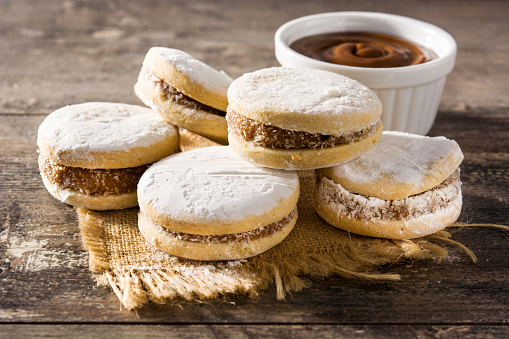Cookies are enjoyable treats everyone loves to try. While most people love to buy them, others prefer to make them in their homes. This way, they can experiment with different cookies with their preferred ingredients. If you’re like those who love to make their cookies, I’m sure you’d love to learn about Alfajores.
Alfajores are delicious Spanish cookies or biscuits, usually filled with dulce de leche. The name comes from the Spanish word, ‘alfajore.” Some alfajores are round, some square, some rectangular, and some even triangular.
If you’d love to learn how to make Alfajores at home, you’re at the right place. This article will guide you through what Alfajore is, its history, and its preparation.
Table of Contents
What are Alfajores?
Alfajores are sandwiches made of two bread discs with a sweet filling. Alfajore is a Spanish word that originated in Mexico, where it refers to a small cake usually served during celebrations like weddings. You can find them in various places, including Peru, Brazil, Latin America, and Uruguay.
In Peru, the people call them alfajores de miel. These are very similar to American brownies, except they are baked in a loaf pan. Instead of being coated with chocolate, they are covered in a thick layer of caramelized sugar. This gives them a unique flavor profile and makes them melt in your mouth.
However, in Brazil, they are known as biscoitos do ceará. These are smaller than regular alfajores and are usually served with coffee. People make them with flour, eggs, butter, baking powder, vanilla extract, and cinnamon. They also sprinkle powdered sugar on them if they wish.
Its original recipe dates back to the early 20th century and consisted of two thin dough circles with a layer of jam. Over time, the recipe evolved, and nowadays, you’ll find many variations of the classic alfajor.
History of Alfajores
Alfajores most probably originated in the Middle East. As early as the eighth century, the recipe reached Spain in the form of a soft cookie filled with cream. During this period, alfajores became popular among the Spanish people as a light snack.
Then, in the 15th century, Spanish conquerors took the recipe to South America. From there, the cookies spread around Latin American countries. Today, you can find them throughout South America.
How to Make Alfajores
Alfajores are made in different styles; however, here’s a simple tip:
- Combine the dry ingredients in a large bowl. Add the butter and cut it into small pieces with a pastry blender or fork.
- Mix the eggs, milk, and vanilla in a separate bowl.
- Add the wet mixture to the dry ingredients and stir well.
- Cover the dough and refrigerate it for 30 minutes.
- Preheat the oven to 350 degrees F. Line a cookie sheet with parchment paper.
- Use a tablespoon to scoop portions of the chilled dough and place them onto the prepared cookie sheet.
- Press each cookie slightly. Bake them for 12 to 15 minutes or until golden brown.
- Let cool completely before serving.
Tips for Making the Best Alfajores
If the mixture appears dry, you can use cold water, milk, or a bit less than half of the flour until the mixture comes together. Once mixed, knead briefly about 10 times until the dough forms a ball. Do not overmix the dough or let it sit for too long; otherwise, the cookies can become burdensome.
Overall, play with the dough very lightly. You want the dough to feel soft and pliable, not stiff. Because the dough is so delicate, there is no need to refrigerate it. Instead, wrap it tightly in plastic and keep it in your refrigerator for up to one week.
To form the cookies, roll the dough into balls about 2 inches in diameter. Place each cookie on a baking sheet lined with parchment paper. Bake the cookies; remove the pan from the oven and allow the cookies to cool completely on the pan. Then, transfer the cooled cookies to a wire rack to finish cooling.
Different Types of Alfajores Fillings
There are many types of alfajores available today. Some are more traditional, while others have been modernized. Here are some examples:
- Chocolate AlfaJorés – These are chocolate-filled cookies. You roll out the dough and bake. After baking, dip the cookies in melted chocolate and allow them to be set.
- Cinnamon AlfaJorés – This type of cookie has a cinnamon filling. It is similar to the chocolate version but uses a lighter dough.
- Coconut AlfaJorés– Coconut is added to the dough along with other spices. Then, you shape the dough into balls and bake.
- Caramel AlfaJorés- Caramel is used instead of jam. Then, roll the dough into balls and bake until golden brown.
- Pistachio AlfaJorés — Pistachios are added to the dough and then baked.
- Mango AlfaJorés— You can add mango to the dough and bake.
- Marshmallow Alfajores – Marshmallows are added to the dough, then rolled into balls and baked.
Conclusion
Alfajores are great snacks you should try, and the best way to enjoy these delicious treats is by making them yourself. The recipes here will help you make the perfect batch of alfajores every time. Enjoy!

